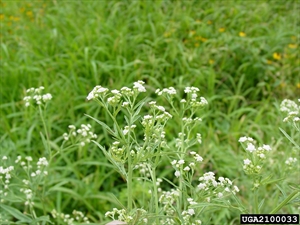- Worldwide distribution. In Australia, French Polynesia, New Caledonia, Papua New Guinea, Vanuatu.
- An aggressive weed flowering early, easily spread, and tolerant to drought. Forms dense stands in disturbed semi-arid environments: roadsides, riverbanks, railway lines, streams, wasteland, agricultural land (many crops, orchards plantations), natural grasslands, pastures. Chemicals from parthenium effect natural biodiversity, carrying capacity of pastures, quality of milk and meat, health of livestock.
- Stems up to 2m, becoming woody, branching, hairy. Leaves alternate up to 30cm, deeply divided, undersides hairy, forming rosette when young. Flowers in clusters from axils and terminal, white, on stalks. Individual flowers arranged in five ray (female) and tiny disc (male) florets. Fruits with five seeds with appendages.
- Spread: seed on the wind, in water; attached to animals, clothing, machinery, vehicles; movement of fodder, soil, sand, gravel.
- Biosecurity: high risk of introduction. In Australia, 'restricted invasive plant': do not release into environment, give away or sell.
- Biocontrol: moth, Pareuchaetes pseudoinsulata; stem-galling fly, Cecidochares connexa.
- Cultural control: pull-out wearing gloves (include basal bulb); plant competitive species leucaena, Tephrosia or ground cover legumes. Clean machinery/vehicles, check clothing, do not move contaminated soil, quarantine livestock 1 week between infested and ‘clean’ pastures.
- Chemical control: in Australia, picloram; fluroxypyr; glyphosate; triclopyr + picloram; triclopyr, picloram + aminopyralid; metsulfuron-methyl; fluroxypyr + aminopyralid. Use on regrowth after slashing.








